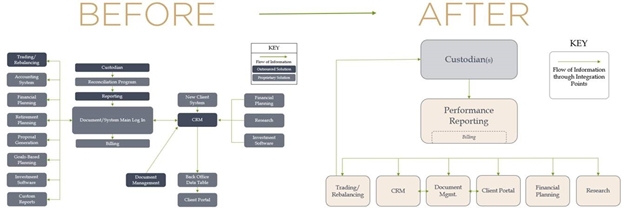The objection we hear most often from prospective clients (delivered in a sarcastic tone) is, “I don’t want to hire an operations and technology consultant. Not only do I have to pay your fee, but you are going to tell me I can’t continue to do business unless I spend an additional $200,000 on new technology that will undoubtedly streamline my operations and make my staff more productive. And after spending all that money, I bet I won’t have one new client to show for it! No, thank you!”
I can’t argue with the advisor’s thinking. In fact, as a business owner myself, I agree that business development should come before streamlining operational efficiencies and worrying about the scalability of your back office. After all, you need a certain level of clients in the door before you need to worry about developing standardized processes that allow you to deliver a consistent level of service across a larger client base. Mark Cuban is famous for saying, “There has never been a company that succeeded without sales. Sales cures all.”
But at some point in every business’ life cycle, the owners will need to realize, “We’ve been growing our top line revenue like crazy for years, but no additional money is hitting the bottom line profitability of the P&L statement. What the heck is going on?” Around this time, they will reach out to us and ask us to perform an Operational Diagnostic so we can spend time onsite with their entire staff and examine their people, processes, and technology being used as they continue to grow and need scale because they are serving more and more clients.
While we will occasionally find a firm trying to do too much with too little, it is far more common that we find the opposite phenomenon. Realizing there is a problem, the owners of the RIA have continued to throw more and more technology at the staff, hoping the next technology tool they implement will be the silver bullet that cures all. While this line of thinking is a problem on many levels, the biggest flaw is that none of the tech tools have a chance of earning firmwide adoption under this scenario — the staff quickly realizes that before they have time to master a new system and begin to gain the full benefits of it, another tool is going to be headed their way.
When we conduct interviews as part of our onsite assessment, we purposely ask the owner(s) to leave the room as we sit down with the staff. More often than not, after hearing from the owner how efficient the organization is and how happy the employees are, the individual employees meet with us and one after the other exclaim, “This place is broken! We have three client portals, two reporting systems, three financial planning tools, and two separate databases that house client contact information, plus our CRM!”
When we ask for details on these various systems, the employees in charge of implementing these solutions across the organization will say, “I don’t even know how that system works – my password expired three months ago and I never bothered to reset it because I know he/she [the owner] will be pushing something different next week as the savior to all of our problems.”
By constantly introducing new systems and asking the staff to learn and implement them, you are distracting employees from their core focus – serving clients. Not to mention the wasted cost of technology systems that are not fully adopted and utilized by the entire organization.
If the above scenario seems all too familiar to your RIA, we urge you to take a step back, reexamine why you initially chose the systems you originally put in place, and determine which one solution will work best for each of the disparate components of your back office. This is the classic addition-by-subtraction scenario – by removing duplicative technology and reducing the overcomplicated web of systems, you will achieve optimized integrations, workflows, and functionality. This in turn will lead to happy employees and satisfied clients, which ultimately will lead to an improved bottom line.


